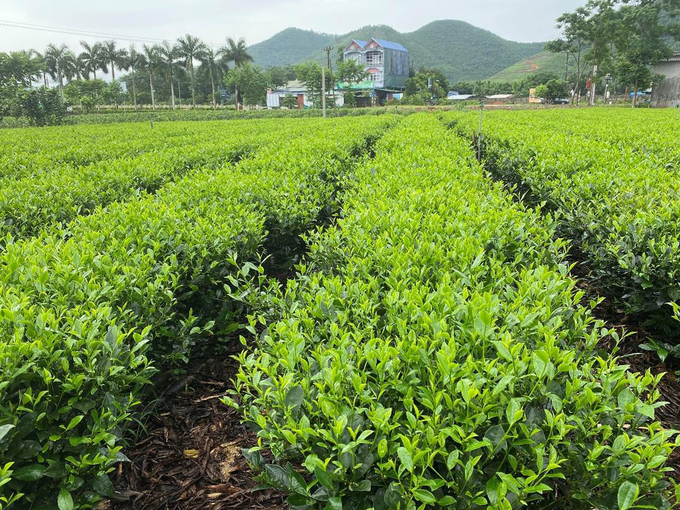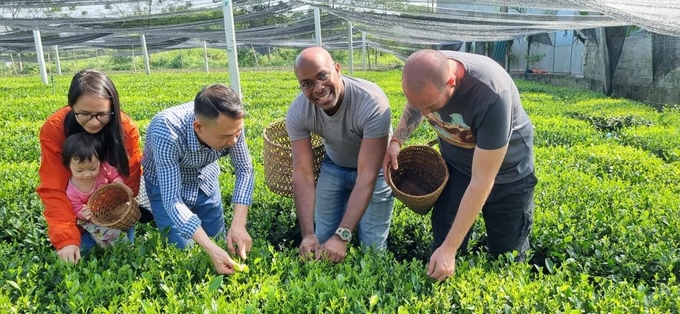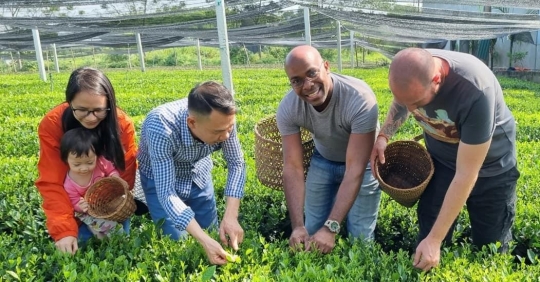[ad_1]
In order to grow organic and ecological tea, it is necessary to gradually restore the “health” of the tea country after a long period of deterioration due to the excessive use of chemicals in production.
Chemical stress in tea cultivation
Tea is one of the crops that have been cultivated in Vietnam for hundreds of years and play a very important role in economic development and social security, especially in the central and mountainous regions where people’s lives still face many difficulties and their income depends on agriculture production.

Covering tea fields with agricultural by-products (straw, acacia bark, eucalyptus, eucalyptus, etc.) combined with rotting organic fertilizers helps improve soil fertility, limit weeds, and reduce the need for chemical fertilizers (Photo taken in Xinjiang, Thai Nguyen). Picture: Pham Hieu.
According to the Ministry of Agriculture and Rural Development, there are nearly 123,000 hectares of tea in Vietnam, which is mainly grown in the northern mountainous provinces and partly in Lam Dong province. Annually, tea production and this industrial chain has an export value of more than US$200 million and helps create millions of jobs for people in rural and mountainous areas.
Compared to other useful plants, tea is a very special plant. 7 to 8 litters are harvested each year. The harvested product consists mainly of tea leaves, which are used for processing and then as a drink. According to the currently popular traditional cultivation method, tea plants are often sprayed with many fertilizers and chemical pesticides or treated with many fertilizers and chemical pesticides before each harvest to ensure productivity and limit pest damage.
Many farmers tentatively assume that each tea field needs to be sprayed with pesticides and fertilized dozens of times every year. This has huge and long-term health implications for the tea farmers themselves, consumers and neighboring ecosystems such as soil, water and biological species.
In recent years, the standard of living of the Vietnamese has steadily improved, and consumers have paid more attention and demanded more about the origin and quality of food. The growing trend towards eco-friendly and clean consumption has opened up opportunities for organic, safe and clearly sourced products.

Applying the liming method with proper dosage helps to minimize tea soil acidification, improve soil fertility and yield and quality of tea plants. Pham Hieu.
Faced with this demand, more and more farmers are being encouraged to adopt organic/organic cultivation methods for tea plants in order to improve product quality and thereby increase the value and income from production. At the same time, agricultural production reduces the negative impact of traditional farming methods on the environment and human health.
However, insufficient attention and research has been paid to the sustainability and effectiveness of these models, and there is no scientific basis that could serve both for imitation and for policy-making by relevant authorities.
The “health” of the tea country must be restored
From 2019 to date under the support and coordination between Deakin University (Australia), the International Union for Biodiversity and Tropical Agriculture (Alliance Biodiversity & CIAT), the Center for International Cooperation on Research Agriculture for Development (CIRAD – France), the Microbiological Biotechnology Network (CMBP) and the Northern Mountainous Agro-Forestry Science and Technology Institute (NOMAFSI), a team of PhD students from Le Viet San (Deakin University) and experts from the above units have conducted research, evaluated and pointed out the negative limitations and long-term effects of traditional tea cultivation, which mainly depend on chemical additives such as fertilizers, pesticides, herbicides, etc., including the deterioration of the function and properties (chemical, physical and biological) of the soil, especially acidification (acidification). The tea soil is quickly destroyed, reducing the diversity and functioning of soil organisms, decreasing the yield and quality of tea plants, and creating numerous risks of pollution of the environment and human health.

The tea garden in Tan Cuong (Thai Nguyen) uses organic farming methods to prepare for harvest. Pham Hieu.
Based on the research results, the expert group has recommended a number of effective and sustainable tea growing methods that can be applied to gradually replace traditional agriculture, i.e. organic farming, by using some measures such as liming and organic products to reduce acidification limit tea soil, which gradually restores the “health” of the tea country and improves the yield, quality and efficiency of tea production in Vietnam. Vietnam.
Some typical models like: Comparing organic farming models and conventional farming models in Xinjiang (Thai Nguyen), the research team showed that households/cooperatives use this model. Organic farming can earn 180-200 million VND/ha more than farmers using traditional farming methods.
This is mainly due to the higher selling price of organic/eco products compared to conventional products. At the same time, farmers and cooperatives that adopt these safe and sustainable farming practices also have better terms of access to concessional credit, materials and technique support programs from domestic and foreign agencies.

The research team conducted the assessment and collected samples on site. Picture: Pham Hieu.
In addition, organic tea cultivation methods help to preserve and improve soil properties and functions, tea bud quality indicators and minimize negative environmental impacts such as: residues of pesticides and heavy metals in soil, water and tea products, This ensures the health of producers and consumers.
In order to solve the problem of tea soil acidification, the use of lime powder with an appropriate amount of fertilizer will help to quickly improve the pH of the soil, thereby improving soil fertility. For example, if the soil pH is 4 to 4.5, the application of powdered lime at a rate of 1.5 ton/ha can help reduce the soil pH by about 0.4 to 0.5 units to increase (decrease acidity), thereby improving the environment for soil organisms to grow, reduces the risk of heavy metal poisoning such as aluminium, manganese, improves the ability to balance soil nutrients…
These research results have been published in renowned international scientific journals and conferences, such as: Environmental Chemistry Letters, Soil Use and Management, Environmental Sustainability, International Phytobiome Conference (USA 2022), 13th International Conference on Agrophysics (Poland, 2021) and domestic journals .

Community tourism activities to experience tea harvest at Tan Cuong Trung Du (Thai Nguyen) Tea Cooperative. Picture: Pham Hieu.
In addition, the application of eco-friendly, organic production also creates opportunities for the development of community experiences and tourism activities, thus helping to promote this farming model and increase economic efficiency for tea producers.
The above results can be a very useful and up-to-date reference for agencies and producers when it comes to choosing a suitable and sustainable production direction that suits the conditions of the family and the place. Meeting the increasing demands of the market, increasing income from agricultural production while ensuring the health of producers and consumers, especially of tea and other agricultural crops. , for a greener and more sustainable agriculture.
[ad_2]
Source link

